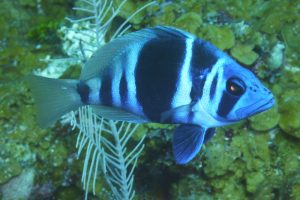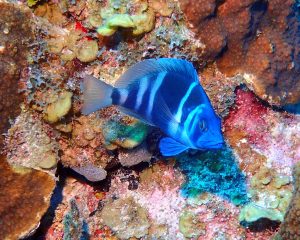Hypoplectrus indigo, or the Indigo Hamlet as it is commonly known, is in the order Percoidea and the family Serranidae. Indigo Hamlets typically grow to be 3-5 inches (about 8-13 centimeters) in length and are known for their beautiful blue and white lateral “bar” striped bodies. They typically have blue colored ventral fins and opaque clear/white pectoral fins and caudal. The fin lines and dorsal fin range from blue to opaque clear/white in color, and they tend to mate with other Hamlets of similar color and stripe patterns.

Although the patterns of striping can differ a bit, all Indigo Hamlets possess the similar blue and white diagonal 5 stripe pattern throughout their life phases which are spent within the safety of the reef. Hamlets are small, oval-shaped fish that have sloping heads and tapered bodies. The Indigo Hamlet ranges throughout the Caribbean island reefs, from the Bay Islands to the Bahamas, Belize, the Cayman Islands. Hamlets are known to stay near the benthic region on and around the coral reefs between 3 and 45 meters, however, that is not to say that they are inactive, as they are often seen swimming around. They are relatively solitary fishes who tend to stick to themselves rather than swim in large schools and are described as highly resilient to the environment. Although they themselves are not a protected species, they do live in some protected reef areas. Hamlets are also simultaneous hermaphrodites, meaning that they have both male and female sexual organs and are able to act as both genders at the same time, which is incredibly rare for vertebrates. Although they do not self fertilize, they do take turns mating as both male and female.

The Hamlet is a carnivorous fish who feeds predominantly on other species of fish and is relatively territorial within its habitat. Because of this, it is possible that the Indigo Hamlet possesses its beautiful coloration for a number of reasons that are similar to other fish species. The patterns and coloration may announce territorial ownership to others, secondly, it may help with courting, and third, it is possible that the bright coloration would be useful for protecting their eggs and hunting grounds. By being brightly colored and patterned, mates will easily spot them as their own species. Furthermore, their bright color and aggressive behavior may draw others away from their territory and eggs.
The information in this chapter is thanks to content contributions from Suki Graham
